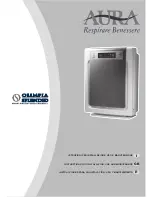
91 / GB
MAINTENANCE
Maintenance is an essential operation to insure safety, correct wor-
king and duration of life of the appliance.
It must be carried out in accordance with the regulations in force.
It is requested to check periodically the pressure of the refrigerant
gas. Before proceeding with maintenance:
• Disconnect the power supply from the appliance
• Close the water taps of the heating circuit
IMPORTANT!
The minimum temperature value of the water in heating, for a cor-
rect functioning of the system, is 20 ° C. During the starting phase
of the machine, it is allowed to work with lower temperatures. If
the air temperature reaches a value below 12 ° C it is necessary
to have a backup energy source. NEVER DISCONNECT THE INTE-
GRATED RESISTIVE ELEMENTS FROM THE TERMINAL BOARD
General remarks
It is necessary to perform at least once a year the following checks:
1. Visual control of the general state of the system.
2. Check for leakage of the hydraulic circuit and possible replace-
ment of the seals.
3. Tightness of the circuit of the refrigerant gas.
4. Check the functioning of the heating safety tools (thermostats).
5. Overall control of the functioning of the appliance.
6. Check the pressure on the heating circuit.
7. Check the pressure of the expansion vessel
8. Keep clean the front grille and the outdoor unit battery pack.
ATTENTION
Empty the components that may contain residual hot water befo-
re manipulating them.
Remove limestone deposits from the components, following the
instructions on the descaling agent used.
Do this in a ventilated room, wearing the necessary safety devices,
avoid mixing of chemical products and protecting the equipment
and surrounding objects.
Information for the user
Inform the user on how the installed appliances work.
In particular, provide the user with the instruction manual, informing
him of the need to keep the booklet close to the appliance.
Also, inform the user of the need to proceed with the following ac-
tions:
• Periodically check the water pressure
• Pressurize the system, when necessary providing an adequate air
purge
• Adjust the parameters setting and devices in order to obtain a
better functioning and a more economical management of the sy-
stem
• Subcontract, as provided by the rules, periodic maintenance
HYDRAULIC CONNECTION
CAUTION!
For countries which have enacted European standard EN
1487, the overpressure device supplied with the appliance
(if present) is non-conforming. The regulatory device must
be calibrated to a maximum pressure of 0.7 MPa (7 bar)
and include at least a cock, check valve and control, safety
valve and hydraulic load cutout.
Some countries may require the use of alternative safety de-
vices, as required by local law; the installer must check the
suitability of the safety device he tends to use.
Do not install any shut-off device (valve, cock, etc.) between
the safety unit and the heater itself.
The appliance’s drain outlet must be connected to a drain
pipe of diam ter at least equal to the of the outlet itself,
with a funnel to permit an airgap of at least 20 mm for visual
inspection to prevent damage or injury to persons, animals
and property when the device operates; the manufacturer is
not liable for any such consequences. Use a hose to connect
the overpressure device to the mains cold water supply; fit a
cock if necessary.
Fit a drain pipe to handle circumstances in which the drain
cock is opened. When installing the overpressure safety de-
vice, do not tighten it fully down, and do not tamper with its
settings. It is normal that water drip from the overpressure
safety device when the appliance is heating. For this reason
one must install a drain, open to the air, with a continuously
downwards sloping pipe, in an area not subject to subzero
temperatures. If the mains pressure is close to the valve’s set-
ting, fit a pressure reducer as far away from the appliance as
possible. If you decide to install mixer units (taps or shower),
purge the pipes of any potentially damaging impurities
first. The appliance must not be supplied with water of
hardness less than 12°F, nor with especially hard water (gre-
ater than 25°F); we recommend installing a water softener,
properly calibrated and controlled - do not allow the residual
hardness to fall below 15°F.
Before using the appliance, we recommend filling its tank
with water and draining it completely so as to remove any
residual impurities.
Antifreeze function of the external unit
The main circulator of the internal unit starts at the minimum
speed when the measured temperature by the return
water temperature (EWT) sensor is below 7°C in heating
mode or the leaving water temperature (LWT) sensor is
below 10°C in heating mode or below 1°C in cooling mode.
The main circulator stops when the return water
temperature (EWT) sensor is above 8°C in heating mode
or the leaving water temperature (LWT) sensor is above
10°C in heating mode or above 4°C in cooling mode.
In case of failure of LWT sensor the protection logics is
based on the outdoor temperature sensor (OAT) of the
external unit.
The main circulator starts when the outdoor temperature
sensor is lower 7°C in heating mode.
The main circulator stops after 30” or when the outdoor
temperature sensor is above 8°C in heating mode.
This check is repeated every 15 min.
Antifreeze function of the internal unit
The main circulator of the internal unit starts at the maximum
speed when the measured temperature by the CH Flow
temperature sensor is below 7°C in heating mode.
If the temperature is still below 9°C after 5 minutes, then the
HP Compressor start at 50% frequency. If the temperature
is still below 9°C after 25 minutes, the resistance is turned
on.
The main circulator stops when the CH Flow temperature
sensor is above 9°C in heating mode.






































